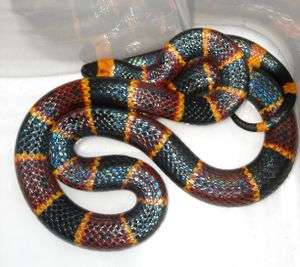Elapidae (Coral Snakes)
Background
- All coral snakes are brightly colored with black, red, and yellow rings
- Red and yellow rings touch in coral snakes, but are separated in nonpoisonous mimics
- "Red touch yellow, kills a fellow; red touch black, venom lack"
- This tool for identifying coral snakes does not apply to Mexican species

Coral snake.
- Venom: mainly neurotoxic (irreversibly binds to acetylcholine receptors)
- Does not cause significant local tissue injury unlike Crotaline (Pit Vipers) venom.
Clinical Features
- Local injury is often minimal and easy to miss as venom is delivered via chewing rather than injection
- Venom effects may develop hours after a bite
Serious complications
- Systemic signs may be delayed up to 13h after bite[1]
- Neurotoxicities in particular for coral snakes
- Local numbness rather than pain/swelling
- Cranial nerve palsies
- Altered mental status
- Weakness
- Respiratory failure due to paralysis
- Hypovolemic shock
- Venom-induced consumption coagulopathy (DIC-like syndrome)[2] (uncommon, but reported[3])
Differential Diagnosis
Envenomations, bites and stings
- Hymenoptera stings (bees, wasps, ants)
- Mammalian bites
- Closed fist infection (Fight bite)
- Marine toxins and envenomations
- Toxins (ciguatera, neurotoxic shellfish poisoning, paralytic shellfish poisoning, scombroid, tetrodotoxin
- Stingers (stingray injury
- Venomous fish (catfish, zebrafish, scorpion fish, stonefish, cone shells, lionfish, sea urchins)
- Nematocysts (coral reef, fire coral, box jellyfish, sea wasp, portuguese man-of-war, sea anemones)
- Phylum porifera (sponges)
- Bites (alligator/crocodile, octopus, shark)
- Scorpion envenomation
- Snake bites
- Spider bites
Evaluation
- CBC with diff
- DIC labs: PT/PTT/INR, fibrinogen, fibrin degradation products, d-dimer
- BMP
- LFTs
- CK
Management
Local Care
- Do:
- Immobilize limb in a neutral position
- Remove all jewelry
- Mark the leading edge of erythema/edema
- Do not:
- Attempt to suck out the venom
- Place the affected part in cold water
- Use a tourniquet or wrap
- Antivenom is first line treatment for compartment syndrome; fasciotomy is last resort if elevated pressures persist.
Antivenom
- Give 3-5 vials of Antivenin (Micrurus fulvius) to ALL patients who have definitely been bitten
- It may not be possible to prevent further effects or reverse effects once they develop
- Additional doses of antivenom are reserved for cases in which symptoms/signs appear
- Prepare for allergic reaction from equine produced Antivenin (may dilute solution, or administer with epinephrine/benadryl)
Monitor for respiratory failure
Disposition
- Admit all patients (even if initially symptom free)
See Also
References
- http://www.emdocs.net/management-of-venomous-snake-bites-in-north-america/
- Isbister GK. Snakebite does not cause disseminated intravascular coagulation: coagulopathy and thrombotic microangiopathy in snake envenoming. Semin Thromb Hemost. 2010 Jun;36(4):444-51.
- https://www.sciencedirect.com/topics/agricultural-and-biological-sciences/elapidae
- Medscape. Antivenin, Eastern & Texas Coral Snakes (Rx) - Antivenin (Micrurus fulvius). http://reference.medscape.com/drug/micrurus-fulvius-antivenin-eastern-texas-coral-snakes-343718.
- Juckett G and Hancox JG. Venomous Snakebites in the United States: Management Review and Update. Am Fam Physician. 2002 Apr 1;65(7):1367-1375.
This article is issued from
Wikem.
The text is licensed under Creative
Commons - Attribution - Sharealike.
Additional terms may apply for the media files.